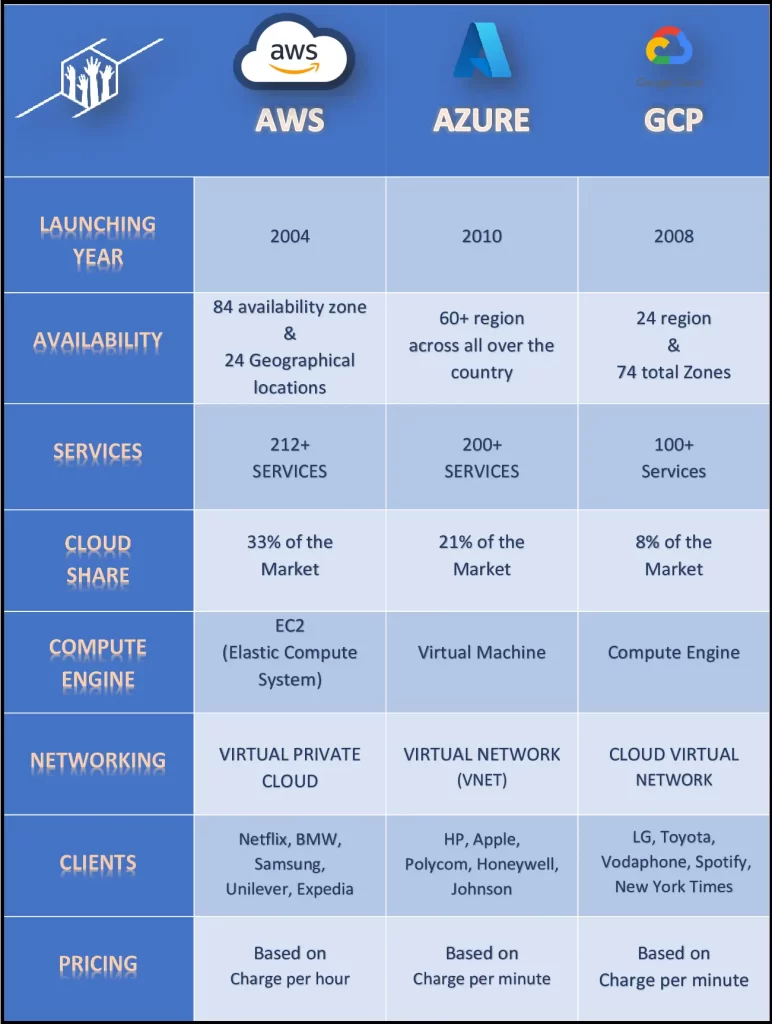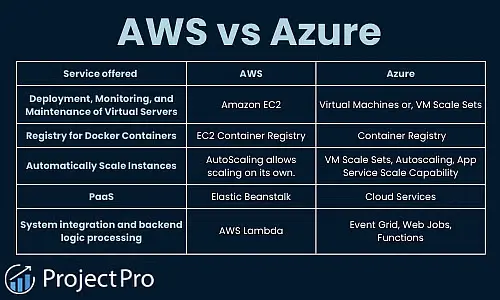Azure vs AWS Reliability: Most Reliable Cloud Platform [2025]
- -
- Time -

Reliability is one of the top priorities for businesses when choosing a cloud platform. Any downtime or security breach can disrupt critical operations and harm business continuity. This is why it is crucial to understand how reliable different cloud providers are before entrusting them with business-critical workloads and sensitive data.
Azure and AWS dominate the cloud market with a combined market share of over 50%. Both providers have invested heavily in building highly available, scalable, and secure infrastructure spread across multiple geographic regions. However, their track records and approach to reliability differ.

In this detailed comparison, we analyze various reliability aspects of AWS and Azure like uptime percentages, geographical coverage, disaster recovery processes, security practices, and more based on the latest information to determine which of these platforms offers the highest reliability today.
Table of Contents
- Overview of Azure and AWS
- Importance of Reliability in Cloud Services
- Key Metrics for Measuring Reliability
- Comparison of AWS and Azure Reliability Aspects (2024)
- Uptime Comparison: AWS vs Azure
- Global Infrastructure: Regional Availability
- Disaster Recovery: Redundancy & Failover
- Network Reliability
- Security Practices
- Service Level Agreements
- Verdict: AWS vs Azure Reliability
- Considerations for Choosing a Cloud Platform
- Conclusion
- FAQs
Overview of Azure and AWS

Azure and AWS are the leading cloud platforms, providing comprehensive solutions for businesses of all sizes. Their robust services empower organizations to drive innovation and streamline operations in the cloud.
Introduction to Azure
Microsoft Azure was first launched in 2010 as Windows Azure, initially focusing on providing infrastructure as a service (IaaS). Since then, Azure has expanded significantly to offer platform as a service (PaaS) and software as a service (SaaS) capabilities across computing, analytics, Internet of Things and more.
Azure now has a global user base that is rapidly approaching the 1 billion mark, with 722.22 million active users according to Azure Active Directory. Additionally, 85% of Fortune 500 companies utilize Microsoft Azure Cloud, demonstrating its widespread adoption in enterprise environments.
Azure’s market share currently stands at 21% in the cloud computing industry, positioning it as a key player in a market projected to be worth $376.36 billion by 2029. As cloud storage continues to grow, it’s estimated that the world will store 200 zettabytes (2 billion terabytes) in the cloud by 2025. Despite Azure’s growth, AWS remains the largest cloud service provider globally, with a market share of around 32% after Q1 2023, though this represents a slight decrease from its 33% share at the start of 2023.
Some of Azure’s key services include Azure Virtual Machines for deploying and managing virtual Windows and Linux servers in the cloud. Azure Virtual Desktop delivers desktops and apps as a managed service hosted in Azure. Azure SQL Database provides fully managed SQL services with auto-patching and backups.
Azure Blob Storage, Azure Files and Azure Data Lake Storage offer scalable storage for data of any size, type and growth rate. Azure Kubernetes Service handles deployment, management and orchestration of containerized applications.
For artificial intelligence, Azure Cognitive Services delivers AI capabilities like speech, language, vision and decision-making through simple APIs. Azure Machine Learning provides a studio for developers to build, test and deploy machine learning models. Azure IoT Hub is a fully managed service that enables reliable and secure bidirectional communication between millions of IoT devices and applications.
Introduction to AWS
Amazon Web Services launched in 2006, with a focus on providing web service infrastructure to Amazon.com’s rapidly growing retail business. Since then AWS has grown into the largest cloud service provider worldwide.
Some of AWS’s core services include Amazon Elastic Compute Cloud (EC2) for scalable compute capacity in the cloud. Amazon Simple Storage Service (S3) provides storage through web service interfaces. AWS Lambda runs code without provisioning or managing servers, with pricing based on the number of requests and execution time.
For databases, AWS offers Amazon Relational Database Service (RDS) for SQL databases, Amazon DynamoDB for key-value and document databases and Amazon Redshift for data warehousing. AWS also provides best-in-class services for artificial intelligence/machine learning, analytics, mobile, internet of things, serverless computing, and more.
Importance of Reliability in Cloud Services
Reliability is crucial because downtime means lost productivity and revenue for businesses. When infrastructure or applications are unavailable, employees cannot work and customer needs cannot be met. This impacts the bottom line. For mission-critical or revenue-generating services, even short outages are unacceptable.
Choosing a cloud provider with a proven track record of reliability gives businesses peace of mind. Customers want assurances that chosen cloud platforms and services will be available as required, without interruptions that risk damaging the brand and customer experience.
Key Metrics for Measuring Reliability
Uptime percentage, SLAs and MTTR are key metrics used to evaluate cloud platforms and make informed choices aligned with business criticality and tolerance for disruptions. This ensures cloud infrastructure supports digital transformation goals and customer-centric strategies for years to come.
The following are the key metrics for measuring reliability:
- Uptime percentage: Uptime is calculated as a percentage of total time when services are functioning without interruptions. Major cloud providers target 99.99% or higher uptime guarantees for most services.
- Service Level Agreements: SLAs typically specify minimum uptime percentages and specify credits if the provider fails to meet those levels. For example, a provider may offer a 50% service credit for outages over 30 minutes.
- Mean Time to Recovery: MTTR refers to the average time it takes a provider to restore full functionality after an outage. Quick MTTR ensures minimal disruption from incidents. Cloud leaders aim to resolve issues within minutes.
Comparison of AWS and Azure Reliability Aspects (2024)
Here’s a table summarizing the key aspects of AWS and Azure’s reliability:
| Aspect | AWS | Azure |
|---|---|---|
| Average Uptime (2023) | 99.99% | 99.995% |
| Geographic Coverage | 26 regions, 80+ availability zones | 34 regions, 60+ countries |
| Disaster Recovery | Multiple Availability Zones, Regional Redundancy | Availability Zones, Zone-Redundant Storage, Paired Regions |
| Network Infrastructure | AWS Global Infrastructure (Private Network) | Azure Network (Private Global Fiber Backbone) |
| Security Practices | DDoS mitigation, ISO 27001, PCI DSS Level 1, HIPAA | DDoS Protection, Advanced Threat Protection, Compliance Tools |
| Service Level Agreements (SLAs) | 10-30% rebate for outages, based on service/region | 10% rebate for regional/subscription outages |
| Industry-Specific Suitability | Extensive storage and AI, pay-as-you-go pricing | Strong compliance tools, centralized management |
Uptime Comparison: AWS vs Azure
Uptime is the most basic and important metric that indicates a cloud provider’s reliability. It is defined as the percentage of time the services were available for use without any downtime during a given period.
AWS Uptime
AWS publishes monthly uptime percentages for each AWS service on their Service Health Dashboard. Some key findings about AWS’s uptime:
- The average monthly uptime for all AWS services combined was 99.99%, which is touted as their “AWS Service Level Agreement (SLA)” commitment.
- A few services like DynamoDB, RDS, S3 consistently maintained 99.99% or above uptime every month without fail.
- EC2 virtual servers in most AWS regions maintained 99.99% uptime or higher on average.
- No single AWS region reported an average monthly uptime of below 99.9% in 2023.
Azure Uptime
Microsoft also publishes monthly Service Health reports with uptime details for each Azure service. Some key insights about Azure uptime include:
- The average monthly uptime for all Azure services combined was 99.995% as per their “Azure SLA” commitment.
- Core storage and compute services like Blob Storage, VMs, SQL Database demonstrated 99.99% or above uptime on average monthly.
- Just like AWS, no Azure region fell below 99.9% average monthly uptime in 2023. Some regions sustained 100% uptime for multiple months.
Therefore, going by published uptime percentages, both AWS and Azure deliver extremely high reliability exceeding 99.99% operational uptime for most services and regions. While Azure had a marginally better average uptime of 99.995%, it isn’t a significant difference from AWS’ 99.99%.
Global Infrastructure: Regional Availability
To offer globally reliable services, cloud providers need extensive global infrastructure coverage. Let’s compare AWS and Azure regions:
- AWS has 26 geographic regions spanning 80+ availability zones worldwide. New regions added in recent years include Mumbai, Indonesia, etc.
- Azure has published availability in 60+ countries via 34 regions as of 2024. It recently added regions in Israel, New Zealand, etc.
Both providers are rapidly expanding to support more local compliance and low-latency needs. AWS aims for 100+ availability zones by 2030.
While AWS leads in the total number of available regions currently, Azure has strengthened its regional presence over the last two years with new regions in key global markets. The geographical footprint has become comparable for mission-critical needs worldwide.
Disaster Recovery: Redundancy & Failover
Having a solid disaster recovery strategy is crucial for continuous, reliable operations in the face of interruptions like fires, floods, power outages, etc. Let’s analyze AWS and Azure approaches:
- AWS uses multiple physically separated Availability Zones within each region for redundancy. Resources can be spread across zones with high-speed networking for quick failovers if needed.
- Similarly, Azure leverages “Availability Zones” and also offers additional options like Zone-Redundant Storage (ZRS) and recoverability using paired regions to replicate data across two regions.
- AWS SLA credits are applicable if an entire region goes down. Azure provides SLA for 99.99% availability of subscription resources within and across data centers too.
- Azure prioritizes low latency traffic routing during failures using its global network to minimize impact. AWS also has proprietary low-latency networks.
Both leaders take redundancy seriously with physically isolated infrastructures within and across regions for continuity even during rare multi-data center failures. Their disaster recovery designs offer enterprise-grade reliability.
Network Reliability
Network uptime and performance are crucial for cloud-based services and applications. Let’s examine the networking aspects:
- AWS operates one of the largest private networks in the world called the AWS Global Infrastructure spanning all regions using proprietary designs.
- Likewise, Azure has a private global fiber backbone called Azure Network with direct private connections bypassing the public internet.
- AWS and Azure both leverage CDNs like CloudFront and Azure CDN respectively to deliver website/app content with low latency worldwide.
- Azure reported zero networking-related outages. AWS network faced just one short outage causing minor S3 issues in 2023.
Summing up, AWS and Azure both offer globally distributed, private networking infrastructures that deliver up to 99.999% availability as per their claims. Enterprises can rely on their highly connected networks.
Security Practices
Security best practices significantly impact reliability, especially against threats like DDoS attacks. Let’s compare their security postures:
- AWS operates one of the largest DDoS mitigation networks in the world spread globally to absorb attacks without affecting customers.
- Azure also has a global network of DDoS Protection services to detect and filter application and network layer DDoS traffic at edge locations.
- AWS achieved multiple compliance certifications like ISO 27001, PCI DSS Level 1, HIPAA. Azure is also compliant with several industry standards.
- Both offer security features like firewalls, private endpoints, access control, encryption, logging, etc. integrated with services.
- Azure has extensive key vaults, a security center, and advanced threat protection tools to monitor workloads.
Overall, AWS and Azure take security very seriously with protections at the network, platform, and application levels aligned to the compliance needs of enterprises and governments.
Service Level Agreements
Availability SLAs state the reliability commitment in monetary terms. Let’s examine AWS and Azure SLAs:
- AWS offers variably rebates for virtual server/storage outages ranging from 10-30% of monthly usage fees credited as account balance.
- Azure provides credits equivalent to 10% of monthly usage fees if an entire region or subscription goes down due to platform issues.
- AWS SLA is applicable if a single AZ/service goes down or a regional outage; Azure needs an entire region/subscription failure.
- Neither platform offers SLAs on high-level services like identity/access management that are harder to make deterministic.
Their SLAs ensure lucrative compensation during rare outages. AWS offers a slightly more granular and flexible SLA coverage though Azure commits an overall higher monthly uptime target.
Verdict: AWS vs Azure Reliability
Summarizing all the parameters, both AWS and Azure have evolved massively into extremely reliable cloud platforms today with global footprints:
- Uptime percentages of their core services exceed 99.99% on average monthly for AWS and Azure.
- Their disaster recovery strategies with multiple zones, regions, and latent data replication provide reliability equivalent to enterprise on-premise setups.
- Extensive networking infrastructure and integrated security controls make them resilient against threats.
- SLAs ensure lucrative compensations during rare individual outages making them enterprise-grade in reliability.
Overall, AWS and Azure are too close to declare a clear winner in reliability.
Considerations for Choosing a Cloud Platform
Selecting the right cloud platform is a critical decision for any business, as it can significantly impact performance, cost, and scalability. Factors such as business requirements, industry-specific reliability needs, and cost versus reliability trade-offs must be carefully evaluated.
The following section will guide you through these considerations.
Business Needs and Requirements
When selecting between Azure and AWS, it is crucial for businesses to consider their unique organizational needs and goals. The choice of a cloud platform should start with understanding how specific services can help achieve strategic objectives.
For example, companies built around the Microsoft stack may find it advantageous to go with Azure due to tighter integration between cloud resources and on-premises systems. Migrating to Azure allows leveraging existing skills and minimizes retraining costs.
On the other hand, organizations seeking extensive storage and AI capabilities at a competitive price point should evaluate AWS. Startups focused on agility may prefer AWS’s pay-as-you-go model over Azure’s commitment-based spending. Overall, aligning cloud investments with technology roadmaps and business priorities lays the foundation for long-term success.
Industry-Specific Reliability Needs
Different industries have varying reliability expectations from cloud providers. For example, healthcare, banking, and government sectors prioritize regulatory compliance and data security overall. They demand robust control over access management and encryption protocols. This makes Azure a suitable choice given its advanced key vault and centralized compliance tools.
On the other hand, media and entertainment businesses require massive scalability to handle fluctuating user loads during events. For them, AWS’s extensive network of availability zones and auto-scaling mechanisms are highly attractive to ensure uninterrupted delivery. Similarly, e-commerce prefers geo-redundancy and high uptime assurances from cloud vendors to avoid revenue loss during downtime.
Cost vs. Reliability Trade-offs
Both AWS and Azure aim to deliver cost-efficiency and reliability. However, certain design choices have implications on these factors. While AWS offers more freedom through its extensive a la carte services, managing resources across zones brings complexity. It requires optimizing costs diligently through reserved instances, savings plans, and Rightsizing.
In contrast, Azure’s packaged solutions simplify operations at a slightly higher expense. Its strong SLA commitments also assure reliable performance for business-critical applications.
To strike the right balance, businesses must comprehensively evaluate usage patterns and risk appetite. AWS fits better for predictable, non-sensitive workloads where optimizations reap high rewards. Azure shines for mission-critical systems needing seamless manageability with a lower risk profile. Hybrid approaches spanning on-premises infrastructure, Azure, and AWS further aid in tapping each platform’s strengths optimally based on resource function instead of origin.
Overall costs depend greatly on how well fit-for-purpose solutions are identified and customized for dynamic business needs through a structured assessment and migration plan.
Conclusion
In conclusion, reliability expectations from cloud platforms differ based on industry and organizational objectives. AWS leads in infrastructure scalability and diverse service offerings while Azure provides tighter integrations and stronger SLAs beneficial for many enterprise workload categories.
Businesses must weigh these reliability-impacting factors against individual priorities like cost control, regulatory mandates, skill sets and change management feasibility to select the optimal solution. Well-defined business and technical requirements evaluation alone uncovers the most suitable deployment architecture spanning on-premise, Azure and AWS resources.
CCS Learning Academy’s AWS and Azure courses offer comprehensive training to equip professionals with the skills needed to navigate these platforms effectively. Our courses help you understand each cloud solution. Enroll today to become proficient in AWS and Azure and lead your business to success in the cloud.
FAQs
Both Azure and AWS ensure high availability and reliability through globally distributed data centers, designed to minimize downtime and maintain performance. They use redundant power, cooling, and networking with failover capabilities to ensure continuous service. Additionally, both offer service level agreements (SLAs) that guarantee high availability percentages.
AWS provides redundancy through its Availability Zones, which are isolated locations within data center regions. AWS services are engineered to operate across multiple Availability Zones to offer fault tolerance and stability. Azure offers similar features with its Availability Sets and paired regions strategy to ensure that applications run redundantly across multiple hardware and geographic locations.
Both platforms offer comprehensive disaster recovery solutions. Azure uses Azure Site Recovery service, which ensures business continuity by keeping applications and workloads running during outages. AWS offers AWS Disaster Recovery, which enables quick recovery of physical and virtual workloads based on customers’ recovery time objectives.
AWS offers an SLA of 99.99% availability for Amazon EC2 and Amazon S3 within each AWS region. Azure promises an SLA of 99.95% for VMs with two or more instances deployed in the same Availability Set. For single-instance VMs using premium storage, Azure offers a 99.9% SLA. These guarantees reflect the commitment of each provider to provide highly reliable services.
Network performance is a critical component of cloud reliability. Both Azure and AWS have a massive backbone of global data centers interconnected by high-speed networks. They continuously invest in network infrastructure to reduce latency and increase throughput, which in turn enhances the overall reliability of their services.
AWS claims data durability of 99.999999999% (11 9’s) for S3, storing data redundantly across multiple devices across a minimum of three Availability Zones in an AWS Region. Azure offers a similar level of data durability, particularly for Blob storage, ensuring that data is replicated in a datacenter or across datacenters.
Both Azure and AWS provide extensive customer support, including 24/7 technical assistance and various support plans tailored to different business needs. AWS distinguishes itself with its range of proactive guidance and architectural support provided under the AWS Enterprise Support plan, which is beneficial for mission-critical applications. Azure’s support plans are similarly structured, offering everything from basic support to more personalized options like Azure Rapid Response or Azure Event Management.
Both platforms continuously innovate to improve reliability; AWS with its advancements in machine learning to predict and prevent infrastructure failures, and Azure with its use of AI in monitoring services to detect and mitigate potential issues automatically.
The choice between Azure and AWS can impact application reliability based on each platform’s specific features and services. Organizations should consider their specific application architecture needs, such as geographic reach, integrations, and specific cloud services when deciding which platform potentially offers higher reliability.
Both Azure and AWS are considered highly reliable with robust infrastructures, advanced redundancy, and continuous service improvements. The perception of reliability can depend heavily on the specific use cases, architectural requirements, and personal experience with each platform. Decision-makers should consider their unique needs and perhaps pilot both platforms to determine which meets their reliability expectations more effectively.






